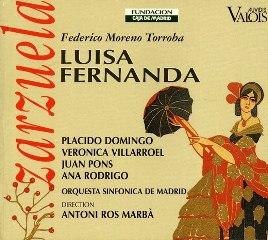Federico Moreno Torroba - Luisa Fernanda (1995)
Federico Moreno Torroba - Luisa Fernanda (1995)

Disc: 1 1. Acte I: Intro Et Premiere Scene 2. Acte I: Habanera Du Savoyard 3. Acte I: Duo De Javier Et Marianna, Romance De Javier 4. Acte I: Duo De Lusia Fernanada Et Vidal 5. Acte I: Duo De Caroliina Et Javier 6. Acte I: Finale De L'acte I 7. Acte II: Premier Tableau: Le Pelerinage De St. Antonie 'De La Florida' 8. Acte II: Premier Tableau: Mazurka Des Ombrelles 9. Acte II: Premier Tableau: Duo De Carolina Et Vidal Disc: 2 1. Acte II: Premier Tableau: Scene 2. Acte II: Deuxieme Tableau 3. Acte II: Troisieme Tableau: Romance De Vidal 4. Acte II: Troisieme Tableau: Finale De L'acte II 5. Acte III: Intro Orch 6. Acte III: Vidal Et Chor Des Gauleurs 7. Acte III: Duo De Luisa Fernanda Et Javier 8. Acte III:Finale De L'acte III Luisa Fernanda, muchacha madrileña hermosa - Verónica Villarroel Carolina, duquesa - Ana Rodrigo Rosita, modista - Isabel Monar Mariana, posadera - Rosa María Ysás Vidal Hernando, hacendado extremeño enamorado de Luisa Fernanda - Juan Pons Javier Moreno, militar, mujeriego y pretendiente de Luisa Fernanda - Plácido Domingo Luís Nogales, revolucionario liberal - Pedro Farrés Aníbal, revolucionario aficionado - Enrique Rodríguez del Portal Saboyano - Santiago Sánchez Jericó Don Florito - Manuel García Jáñez Bizco Porras - Gregorio Poblador Don Lucas - Salvador Baladez Solano Capitán - Martín Grijalba Coro de la Universidad Politécnica de Madrid Orquesta Sinfónica de Madrid Antoni Ros Marbà – director
Esta es una de las mejores versiones de una de las obras maestras del género lírico español. Esta versión (completa a más no pder)incluye pasajes que suelen ser omitidos en las versiones actuales de la obra, lo que se agradece para conocer por completo la gran partitura. En el soberbio reparto brillan con luz propia el Vidal de JUAN PONS, soberbio en lo vocal y de notable actuación dramática y la sensible y bien matizada Luisa Fernanda de VERÓNICA VILLARROEL. PLÁCIDO DOMINGO es un arraigado Javier, mientras que la Duquesa Carolina de la lírico-ligera ANA RODRIGO queda algo desdibujada entre todos sus compañeros. El amplio elenco de secundarios cumple sobradamente, destacando la prestación de SANTIAGO S. JERICÓ, que canta muy bien la conocida romanza del Saboyano. La orquesta y el coro cumplen de manera notable bajo la batuta vivaz de ANTONI ROS MARBÁ. Un disco para no perderselo
Enormously popular (over 10,000 performances to date) and considered one of the finest twentieth century zarzuelas, this work with its compelling melodies and excellent libretto by Federico Romero and Guillermo Fernández Shaw was premiered at the Teatro Calderón in Madrid on March 26, 1932, a year after the declaration of the Republic, an event that would certainly have been evoked in the minds of the first audiences. This work of great emotional range is technically described as a Viennese-style "lyric comedy," but it is also in text and music style about "verismo" revolutionary politics, about Spanish city manners contrasted with country manners and musics, about romantic feelings mixed with tragedy.
Act I is set in 1868 Madrid during the reign of Isabel II as the royalists and republicans struggle. Innkeeper Mariana chats with her lodgers Rosita, a seamstress, republican Don Luís Nogales, and his young follower Aníbal. Luisa Fernanda, courted by rich landowner and monarchist Vidal Hernando, is actually in love with Javier, a colonel in the royal hussars, who is a skirt-chaser and rather nonchalant in his attitude toward Luisa. Javier is tired of the quiet city life (romanza: "De este apacible rincón de Madrid"). Aníbal attempts to interest Javier in the revolution. Astonishingly, Javier falls for the Queen's lady-in-waiting Duchess Carolina and becomes a royalist, at which point Vidal negotiates a political turnabout and becomes a revolutionary in order to fight his rival for Luisa's affections.
In Act II, scene 1, a charity collection is being held outside the Oratory of San Antonio. We hear street vendors and musicians, and "sombrilleros" asking St. Anthony to send them lovers (mazurka: "A San Antonio"). Carolina offers Vidal a large bribe to switch allegiances again but he refuses (duet: "Para comprar a un hombre"). Luisa decides to accept Vidal 's true love and to reject Javier's arrogance and possessiveness (trio: "¡Cuánto tiempo sin verte, Luisa Fernanda!").
Scene 2 takes place at the Calle de Toledo at dawn, where Nogales makes a morale-boosting speech about liberty to his rebels.
In scene 3, Javier is captured but Luisa defends him against a crowd calling for his execution. The hussars overtake the rebels again and free Javier. Nogales is taken in Vidal's place, and Luisa promises to marry the wounded Vidal.
At Vidal's country estate "La Frondosa," at Piedras Albas in Extramadura, the marriage is about to take place, when news arrives that the Queen has been dethroned, Duchess Carolina exiled, and Javier is missing. A chorus of vareadores (harvesters) together with Vidal praise the impending marriage (coro y romanza: "¡Ay mi morena, morena clara!"). Javier, wounded in Portugal, returns and pleads with Luisa to return to him. However, Luisa still declares she will marry Vidal even though she continues to love Javier (duo: "¡Cállate, corazón!"). Vidal eventually understands that Luisa really loves Javier, and, in a final act of true love, releases Luisa from her marriage promise. At the opera's end, he has only his memories for comfort. --- "Blue" Gene Tyranny, Rovi
download: uploaded yandex 4shared mediafire solidfiles mega zalivalka filecloudio anonfiles oboom
Last Updated (Wednesday, 11 June 2014 12:27)








